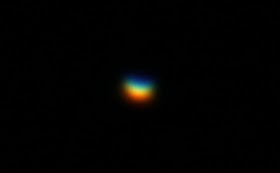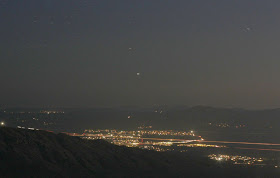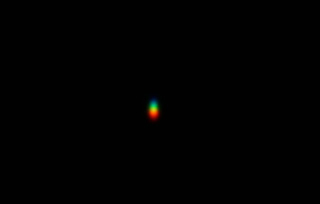Melinda and I took a late afternoon drive last week to
"A" Mountain (Sentinel Peak), up in the foothills of the Tucson Mountains overlooking the Tucson Valley from the west. As you can guess from the name, there is a big "A" on the slope, for the local U of A, or in case anyone forgets what state they're in! In any event, it is a popular destination to check out the view of the city till it closes in the evening (mountain access, that is...).

The reason for our visit was to take some photos in the growing twilight. I'd been corresponding with our friend Dick, who has gotten me into making panorama images. I took a series of vertical format shots with the Canon XSi and the 70-200mm lens set to about 150mm, 1.3 seconds at ISO 200. The 5 images were stitched automatically in Photoshop, and viola, a panorama! At it's native resolution of nearly 12,000X4000 pixels, it is easy to get lost roaming around the environs of downtown Tucson and the University. Unfortunately, our blogging software limits the picture to 1600 pixels wide, so you can't enjoy the same tour, but I can show you selected highlights! Be sure to click on the images for the full-size views...

Just like playing "Where's Waldo", looking out of place for what counts as skyscrapers in Tucson is the tile dome of the old Pima County Courthouse, built in 1929 in Spanish Colonial Revival style. It is now surrounded by newer court buildings, but the old courthouse certainly adds a bit of class to the boxy structures of the city. The only time I've been in it was to collect juror pay a couple decades ago, and I think it now serves as offices for the county treasurer and recorder.

Just above the courthouse in the large shot above is Melinda's workplace, the University Medical Center. The large building on the left is the new Diamond Children's Center, named for Don Diamond, a local developer. Melinda works at the NICU on the 4th of 6 floors - green lights on top are for the heliport. The building to the right is the main building of UMC, where I've spent lots of time the last few years, it seems!

The last of the "highlights" is a recognizable landmark - Arizona Stadium! Of course, I work under the east stands at the Mirror Lab, unfortunately not visible from the west. Space under the west stands, also unfortunately not visible behind new dormitory construction, is the
Laboratory of Tree Ring Research, interestingly, started by the same fellow who started Steward Observatory in the early years of the last century- A.E Douglas! What is interesting to me is that the 18" high letters that spell "ARIZONA" is resolved from the 4 miles or so distance to our observing spot in the camera lens.

While it is fun cruising around the full resolution version, I was mystified by the wiggling headlights of the cars. If you look closely at the headlight streaks in the 1.3 second exposures, they oscillate over part of the exposure. In exchanges with some of Dick's friends, it seems that the mirror and shutter slap in the camera causes some low-level vibration even though a tripod was used. In future attempts I'll try mirror lockup to minimize the effect. It didn't seem to affect the overall sharpness too much, though...

And just to show that we were indeed on A Mountain, as we turned to leave we took a shot of the "A". It used to be painted white, but since 9/11, it has been red/white/blue. The color has not been without controversy, since groups paint it green on St Pat's Day, and if they don't get caught, marauding ASU students try to paint it it maroon and gold before their Fall football matchup. There has been some call for a return to white, myself among them, but we're still waiting... The bright object in the upper corner is Jupiter, still dominating the western sky.
 The reason for our visit was to take some photos in the growing twilight. I'd been corresponding with our friend Dick, who has gotten me into making panorama images. I took a series of vertical format shots with the Canon XSi and the 70-200mm lens set to about 150mm, 1.3 seconds at ISO 200. The 5 images were stitched automatically in Photoshop, and viola, a panorama! At it's native resolution of nearly 12,000X4000 pixels, it is easy to get lost roaming around the environs of downtown Tucson and the University. Unfortunately, our blogging software limits the picture to 1600 pixels wide, so you can't enjoy the same tour, but I can show you selected highlights! Be sure to click on the images for the full-size views...
The reason for our visit was to take some photos in the growing twilight. I'd been corresponding with our friend Dick, who has gotten me into making panorama images. I took a series of vertical format shots with the Canon XSi and the 70-200mm lens set to about 150mm, 1.3 seconds at ISO 200. The 5 images were stitched automatically in Photoshop, and viola, a panorama! At it's native resolution of nearly 12,000X4000 pixels, it is easy to get lost roaming around the environs of downtown Tucson and the University. Unfortunately, our blogging software limits the picture to 1600 pixels wide, so you can't enjoy the same tour, but I can show you selected highlights! Be sure to click on the images for the full-size views... Just like playing "Where's Waldo", looking out of place for what counts as skyscrapers in Tucson is the tile dome of the old Pima County Courthouse, built in 1929 in Spanish Colonial Revival style. It is now surrounded by newer court buildings, but the old courthouse certainly adds a bit of class to the boxy structures of the city. The only time I've been in it was to collect juror pay a couple decades ago, and I think it now serves as offices for the county treasurer and recorder.
Just like playing "Where's Waldo", looking out of place for what counts as skyscrapers in Tucson is the tile dome of the old Pima County Courthouse, built in 1929 in Spanish Colonial Revival style. It is now surrounded by newer court buildings, but the old courthouse certainly adds a bit of class to the boxy structures of the city. The only time I've been in it was to collect juror pay a couple decades ago, and I think it now serves as offices for the county treasurer and recorder. Just above the courthouse in the large shot above is Melinda's workplace, the University Medical Center. The large building on the left is the new Diamond Children's Center, named for Don Diamond, a local developer. Melinda works at the NICU on the 4th of 6 floors - green lights on top are for the heliport. The building to the right is the main building of UMC, where I've spent lots of time the last few years, it seems!
Just above the courthouse in the large shot above is Melinda's workplace, the University Medical Center. The large building on the left is the new Diamond Children's Center, named for Don Diamond, a local developer. Melinda works at the NICU on the 4th of 6 floors - green lights on top are for the heliport. The building to the right is the main building of UMC, where I've spent lots of time the last few years, it seems! The last of the "highlights" is a recognizable landmark - Arizona Stadium! Of course, I work under the east stands at the Mirror Lab, unfortunately not visible from the west. Space under the west stands, also unfortunately not visible behind new dormitory construction, is the Laboratory of Tree Ring Research, interestingly, started by the same fellow who started Steward Observatory in the early years of the last century- A.E Douglas! What is interesting to me is that the 18" high letters that spell "ARIZONA" is resolved from the 4 miles or so distance to our observing spot in the camera lens.
The last of the "highlights" is a recognizable landmark - Arizona Stadium! Of course, I work under the east stands at the Mirror Lab, unfortunately not visible from the west. Space under the west stands, also unfortunately not visible behind new dormitory construction, is the Laboratory of Tree Ring Research, interestingly, started by the same fellow who started Steward Observatory in the early years of the last century- A.E Douglas! What is interesting to me is that the 18" high letters that spell "ARIZONA" is resolved from the 4 miles or so distance to our observing spot in the camera lens. While it is fun cruising around the full resolution version, I was mystified by the wiggling headlights of the cars. If you look closely at the headlight streaks in the 1.3 second exposures, they oscillate over part of the exposure. In exchanges with some of Dick's friends, it seems that the mirror and shutter slap in the camera causes some low-level vibration even though a tripod was used. In future attempts I'll try mirror lockup to minimize the effect. It didn't seem to affect the overall sharpness too much, though...
While it is fun cruising around the full resolution version, I was mystified by the wiggling headlights of the cars. If you look closely at the headlight streaks in the 1.3 second exposures, they oscillate over part of the exposure. In exchanges with some of Dick's friends, it seems that the mirror and shutter slap in the camera causes some low-level vibration even though a tripod was used. In future attempts I'll try mirror lockup to minimize the effect. It didn't seem to affect the overall sharpness too much, though... And just to show that we were indeed on A Mountain, as we turned to leave we took a shot of the "A". It used to be painted white, but since 9/11, it has been red/white/blue. The color has not been without controversy, since groups paint it green on St Pat's Day, and if they don't get caught, marauding ASU students try to paint it it maroon and gold before their Fall football matchup. There has been some call for a return to white, myself among them, but we're still waiting... The bright object in the upper corner is Jupiter, still dominating the western sky.
And just to show that we were indeed on A Mountain, as we turned to leave we took a shot of the "A". It used to be painted white, but since 9/11, it has been red/white/blue. The color has not been without controversy, since groups paint it green on St Pat's Day, and if they don't get caught, marauding ASU students try to paint it it maroon and gold before their Fall football matchup. There has been some call for a return to white, myself among them, but we're still waiting... The bright object in the upper corner is Jupiter, still dominating the western sky.





















